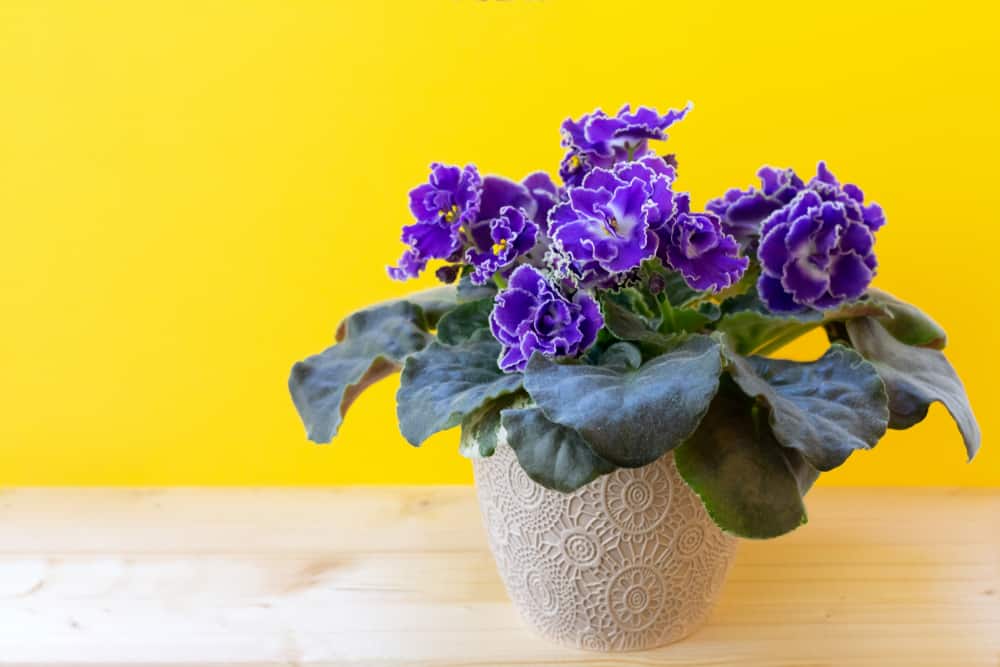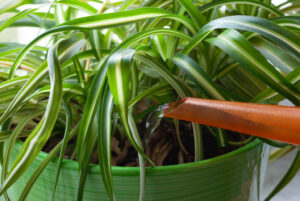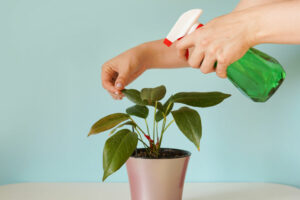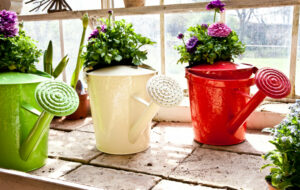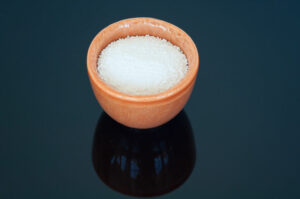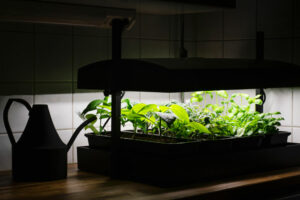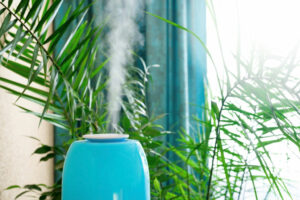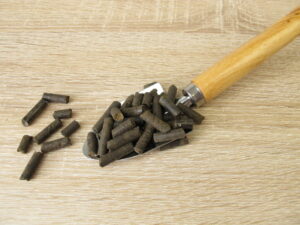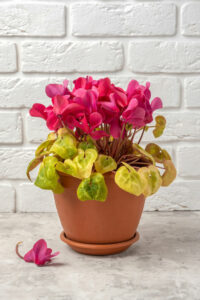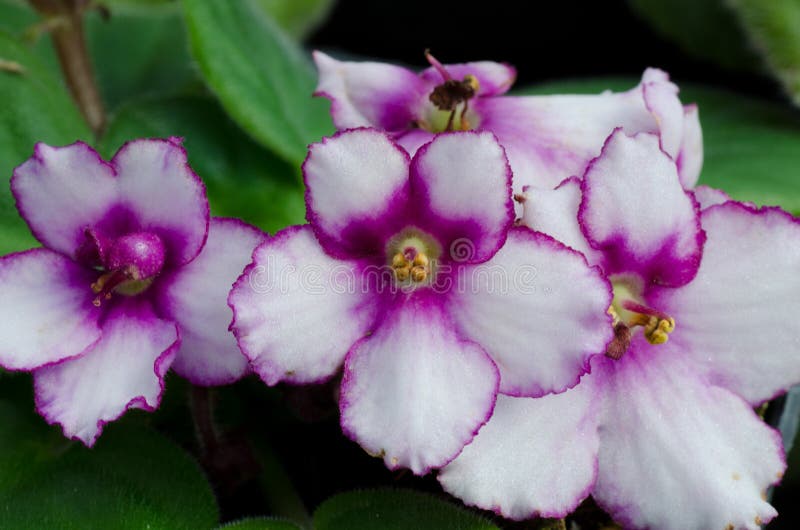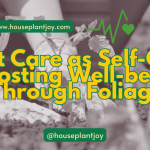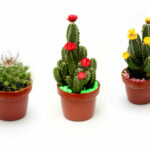HousePlantJoy is supported by our audience. When you purchase through one of our links, we may earn a small affiliate commission. As an Amazon Associate I earn from qualifying purchases. Your cost is not affected.
==================
African Violet Plants always look interesting. Usually African Violets can grow well in your home, no matter their color. The most loved house plants in the world are these beautiful flowers. White, blue, or purple clusters of flowers represent loyalty, faithfulness, and dedication. Their soft, colorful leaves will brighten your home and make you smile. African Violet care? Keep reading to know more about it.
Looking at the violet plant will make you feel better because it sends more oxygen and good chemicals to the brain. African violets clean the air by filtering out benzene and other dangerous chemicals. You will be able to breathe more easily as a result. Bright, indirect light is ideal for African violets, as they put forth the most flowers. But even though they are usually easy to take care of, they can get fussy sometimes. Don’t give up hope!
Continue reading to know more about African violets and how to take care of them.
African violet plants were first grown in Tanzania, which is in Africa. Usually African violets used to grow well in the coastal forests of Kenya and Tanzania and the Eastern Arc Mountains’ forests. But these forests are going away quickly. African violets could go extinct in their natural environments because too many trees are being cut down to make room for crops. These small plants can’t stand bright light that doesn’t get blocked. But they do well in dim or filtered light. Now that the trees are gone, the plants can get direct sunlight. The direct sunlight is killing these violets that grow close to the ground.
Are African Violets Violet?
They are usually colored violet. However, even though they look like a true violet plant, they are not. All these are “Saintpaulia plants,” There are nine species, eight subspecies, and two varieties, for a total of about 16000 cultivars. But the most common is Saintpaulia Ionantha. Except for Saintpaulia Ionantha, nearly all African violet species and subspecies are sensitive, compromised, or extinct. All the species have fuzzy leaves and flowers that look like violets. The flowers of the wild species have splashes of other colors. Crossbreeding between the cultivars has led to all these amazing flowers.
The same care is necessary for all African violets, no matter what type you choose to grow.
African Violet Family
Baron von Saint Paul discovered the african violets or Saintpaulia plant in Tanzania in 1892. The genus Saintpaulia is named Baron von Saintpaulia. It’s name “ionantha” means violet, the color of flowers. African violets are members of the Gesneriaceae family, including Cape primrose and Gloxinia. No longer just violet, these lovely flowering plants also come in other colors.
Top 5 known types of african violet family
1. Cherry princess
With its delicate pink blossoms and purple hues, Cherry Princess, one of the types of african violet plants, is a stunning beauty. It looks great in ceramic planters as a decorative touch. This gorgeous variety has fuchsia blossoms with white edges. And this bright one makes any room more colorful and interesting.
2. Persian prince
This small African violet is a popular selection. Persian Prince has beautiful medium-blue flowers, but the foliage stands out. The leaves’ edges are scalloped, making the whole plant even more beautiful.
3. Summer twilight violet plant
Summer Twilight is a popular African violet that is loved for how beautiful it looks. It has beautiful lilac-purple flowers with a white edge and leaves of many different colors. This type has purple petals with white edges that are ruffled. Large flowers would be interesting enough, but the leaves are also different. The leaves are dark green in the middle and get lighter green and beige as they move outward.
4. Little maya plant
Little Maya is among the most popular forms of african violets. It has beautiful flowers that are crimson red. It was first sold in 1997 and has been a favorite of people who like houseplants.
5. Julia violet plant
Julia shows off soft flowers that are of different colors and shapes. It is one of the unique kinds of african violets and doesn’t need much care.
Benefits Of African Violets
Here are a few reasons why you should get one of these african violet plants:
-
- African violet blooms are edible.
- It grows easily. An excellent pick for first-timers!
- The small tiny flower blooms almost all year, bringing your area a nice look.
- It can make you feel less stressed just by looking at it.
- It is a lively plant with a shape that makes it look like a heart, symbolizing love.
- Mother’s Day gifts usually include african violets.
- Violets are the birth flower for February so that they can be a happy gift for a friend’s birthday February.
- It won’t hurt your pets if they nibble on it. The violet plant is safe for pets and children because it is not poisonous.
- It can grow with the help of lights.
- “Water kills plants!” is a myth. Water itself doesn’t hurt plants, but the water temperature does.
- Hairs on their leaves make them look velvety, and these hairs can take water from the air.
- It can grow from leaf cuttings or, in some cases, from branches that grow independently.
- Taking off the spent flowers will help the new ones grow.
- It will make more flowers in small pots because it will put its energy into blooming instead of growing.
- By using hybridization, you can mix any colors you want to make a pretty combination.
African Violet Care And Growth
Here are the best tips to help your African Violets grow and stay healthy:
Watering african violets
African violets do well in either wet or dry soil, but they don’t like soil that is too wet. When the soil looks dry, you should water it. The safest way to water is from the bottom with water at room temperature since water on the leaves straight can cause patches. Put the pot in water so the plant can get water from the bottom. Don’t overwater your plant, as this can promote bacterial growth or denitrification.
When watering your african violet plants, keep these factors in mind:
1. Water temperature
Ensure the water you use is room temperature to keep your African violets happy. Keep the plant’s fuzzy leaves and stems dry to avoid rotting or fungal growth. The water temperature should be the same as the air temperature around the plant. It shouldn’t be too cold or too hot. When water is cold, it hurts the roots of plants. When a violet plant takes in too much cold water, it chills the roots, making the leaves curl. Thus, tepid water is best.
2. Bottom watering
This gravity-defying method uses the natural wicking action of soil to wet the entire substrate gradually. The approach applies to both loose and compact soil. It works well for different types of african violet plants that can be easily moved. To keep the leaves from getting wet, it’s best to water from the bottom. It’s important to remember that water shouldn’t touch the leaves because that causes brown spots that are hard to get rid of. You can place your pot on a water-filled tray for an hour.
Pros and cons of bottom watering
Pros
- Bottom-watering makes sure that the entire mass of soil is wet. Instead of water from the top down, which can leave dry spots, soak from the bottom up.
- It brings the soil back to its normal moisture level. Bottom watering is a great way to revive a plant whose soil is dry because you forgot to water it. It’s how to bring a plant back to life if it isn’t hurt too badly.
- Bottom watering prevents water from resting on leaves and soaking in joints. It keeps things from getting wet and rotting, which can lead to bacteria and fungi problems.
- Bottom watering wets the soil under the plant, making the roots grow down. Even a short soak that doesn’t reach the soil’s top will keep the soil’s lower parts moist.
Cons
- Even though we discussed how bottom watering could save time, it depends on the situation. Watering from the bottom needs less effort, but the soak duration is greater.
- One of the biggest problems with bottom watering is that you can’t get salts out of the soil. When you water from the top, fertilizer salts drain to the bottom.
- When you water plants from below, the soil will soak up all the water it can hold. But, if you use the right soil for your plant, this can be great. Click here to learn more about what makes the best soil.
3. Spray misting
Spraying the area makes it more humid without leaving big drops of water on the leaves, which can cause brown spots. Morning and night are the best times to spray plants that need to grow. The morning mist prepares them for the day, and the nightly rain gives them a little extra moisture. Try misting your african violets!
4. Self-watering devices
Many self-watering devices reduce the risk of fungal infection or plant rot. These devices follow bottom watering procedures, reducing the risk of leaf stains from top watering. African violets and other indoor plants do well in self-watering pots because they keep the roots moist, provide a steady water supply, and keep the plants’ nutrients. Below are a few self-watering devices you can consider:
- Plant Self-watering Spikes and Globes
- Self-watering Pots
- Humidity Mats and Water Trays
5. Soft water
You can eliminate minerals in hard water by treating them with sodium or potassium. Still, softened water is not a good idea for watering your garden because it usually has a lot of sodium. Most violet plants can’t stand being in a lot of salt, so if you rely only on softened water to water your violet plants, you might have problems with them. If your plants get a lot of rain, a little soft water won’t hurt them. Even if you use water that has been treated with sodium chloride, you shouldn’t rely only on it for watering your plants. African violet watering with sodium chloride can build up in the soil over time, making it more difficult for plants to thrive.
What is the difference between hard and soft water?
Hard water contains many dissolved minerals, such as calcium and magnesium. Soft water is rainwater or processed water in which only sodium ions are present.
It’s fine to give your african violet plants hard water. But gardens with many different or fragile plants may have trouble, especially if their only source of water is hard water. Watch out for damage caused by water with a high alkaline pH or many minerals.
But it’s fine to use soft water, but it won’t help your garden. And soft water must not always use often in gardens that get rain from the sky. If not, you can use tap water to water your indoor plants.
6. Chlorinated water
The water supply in most cities has chlorine added to it. But only a small amount of chlorine is needed for photosynthesis. If you can smell the choline in the water, it’s too much for your little plants. This much chlorine can stop your african violets from growing. African violet watering with chlorine is not good for the violet plant.
The city adds chlorine to tap water to kill bacteria and make it safe to drink, but chlorine can also kill african violet plants. Toxic doses are always more potent than toxic ones. But chlorine is a necessary nutrient for plants at low concentrations. When concentrations get to dangerous levels, it becomes poisonous.
African Violets Light Requirements
For african Violet plant care, light is very important. Photosynthesis needs light, and plants can’t live in total darkness. But the best light for african violets is low or indirect. Your violet plant can die if it gets too much light. Try checking out if you want to know the best low-light plants!
When african violet needs light?
Here are some tips about how much light African Violets need:
- African violet plants need about 10 hours of bright, indirect light and 6 to 8 hours of darkness daily. If the plant doesn’t get enough light, it will stop flowering, grow tall, and the leaves will start to turn beige.
- If you want enough light for your african violet, choose a window facing west or south. To filter light, you can use sheer curtains or blinds that do the same thing.
- Use a brightness of 10,000 to 12,000 lux for african violets.
- Turn your potted indoor violets often so that each side gets light. African violets grow to light, so if you don’t turn them, the side facing the window would grow longer.
- When african violet plants are in direct sunlight, the leaves can turn all green or curl downward. The plant also has signs like brown spots that look like sunburns.
- During the winter, keep in mind that your violet plants get more sunlight than usual.
- When there isn’t enough sunlight, grow lights aid African violets grow.
- Many people find it a lot easier to grow this violet plant indoors with the help of grow lights. It lets you control how much light your african violet gets to ensure it blooms and grows well.
Grow lights for african violets
You can get the most flowering and development from your african violet using full-spectrum lighting. Grow lights with red and blue spectrums will help African violets thrive. Adding red and blue LED lights to the existing system of grow lights can help boost light output in these key wavelength ranges. Photosynthesis is aided by blue lighting, while the violets plant benefits from red lighting.
- Using full-spectrum lights allows you to maximize blooming and growth. You can control the light optimally as red and blue light, are essential for flowering and photosynthesis, respectively.
- Full-spectrum LEDs will provide a range of shades of light and by choosing a certain range you can stimulate the growth.
- Using full-spectrum lights you can focus on any character you want to stimulate, either blossoming or growth, with simple adjustments.
- It’s important to note that placing grow lights too close to an African violet plant can cause leaf burn similar to when exposed to direct sunlight.
- Make sure, your plant receives at least 8 hours of dark period or light period, no more than 16 hours.
- Grow lights can cause leaf blanching which can only be treated by placing your violet in sunlight.
What Temperature Is Good For African Violets?
Plants like african violets grow in an environment that is pleasant. About 70 degrees Fahrenheit is ideal for them. Your violets will be as long as you are at ease. Keep the temperature around 60°F to 80°F for African violets, as they can’t handle excessive swings.
Low temperature
If the temperature is below 60°F, the african violet plant will grow slowly and bloom less. The violet plant starts to die because of these deadly conditions. A lot of water encourages bad growth, like crown rot. African violets are grown mainly indoors, where the temperature is usually just right.
High temperature
Another african violet plant care tip. If the temperature goes above 80 degrees, the african violet plant’s leaves can dry out and shrink. It stops the violet plant from flowering and makes the flowers fall off. But to keep your plant healthy in this heat, you should water and fertilize it often and ensure it gets a lot of air.
African Violet Care Humidity
In African Violet Plants’ natural habitat, the humidity is between 70 and 80%. It is hard to do in most homes, so keep the humidity around your violets at 50–60%. When there is less humidity, your african violets care will sweat more, which will dry out the leaves, keep buds from opening, and slow the plant’s growth. To make a microclimate, put your african violets close to each other. But this will raise the humidity around the violet plants by up to 15%. You could use a self-watering device that helps keep the humidity level steady, or you could just put a water container near your plants. Use a warm-mist or cool-mist humidifier instead, depending on the season.
Fungi can’t grow on african violets if they get enough airflow and have enough humidity.
Potting And Repotting African Violets
Use soil with a pH between 6 and 6.5 for the best results. Perlite, peat, and vermiculite are the three main elements in the appropriate potting mix. As a result, it aids in increasing growth and progress. Buying a pre-made potting mix or making your own at home are two options for growing plants. 5- to 6-inch-diameter pot is ideal for a mature plant.
When an african violet plant grows too big for its pot, repotting it is a must. Move your plant to a bigger pot, but don’t touch the roots to keep it blooming. But most people who successfully grow violet plants repot African violets every six months. But if the leaves start to fall off, it’s time to move the african plant to a new pot.
Tips on potting and repotting african violets
When potting and repotting african violets care, be sure to consider the following:
- Before repotting the violet plant, soak it in a lot of water for an hour or put it on a saucer of water. So, taking the african violet plant out of its pot will be easier. Plastic containers that bend a little to allow the root ball to glide out can be used to skip this stage.
- To live, african violets need potting soil that has been carefully prepared. You can buy a good mix or make your own by mixing equal parts of garden loam, sand, and peat moss. Remember, before planting, give the soil a light soak.
- When you’re ready to move your houseplant, loosen the soil around it and turn it over. Then put it all in the new pot. Don’t worry if some of the old soil stays on the roots. Soon they’ll grow through drainage holes and plant roots in the soil.
Fertilizer For African Violets
To make your african violets bloom, treat them like you would any other flower. But give them water and fertilizer once a week and apply it every three days.
But if you have African violets, you can use or buy liquid plant food on them. Another option is to make homemade fertilizer by mixing one part baking soda with three parts water and adding a spoon of hydrogen peroxide. It will kill fungus and encourage blooming.
If you see brown or dead spots on leaf tips, your plant may be getting too much fertilizer. IBut it could be overfed if you notice the wilting or jelly-like texture.
African Violets Problems
PEST: The cyclamen mite and the cockroach are two common pests of african violet plants. The cockroach eats the flowers, making it seem like your plants have stopped blooming. It strikes at night; you won’t be able to catch it easily. A trip attacks african violet pollens. Aphids suck the moisture-filled leaves, making them wilt and turn beige. When attacked, leaves wilt and turn beige.
DISEASE: Temperature fluctuations can bring Powdery Mildew and Botrytis blight, a common and often dangerous fungal disease that can harm plants. But a poor airflow leads to the growth of fungi, which in turn leads to this disease, and forms gray molds on plants. This situation can progress to crown rot if it’s accompanied by dampness.
But if you think your violets might have a disease or pest, put them in a separate area. Keep the air flowing well. Thus using them is a good idea.
Conclusion
Choose from one of these African violets care. African Violets’ purple hue has been found to have health-promoting properties just by glancing at it. When you look at it, your adrenaline levels rise and the oxygen levels in your brain rise, contributing to a feeling of relaxation.
In contrast to many other plants, african violets are grown for their beautiful flowers. People say that African violets are hard to grow, but if you know what you’re doing, they’re pretty easy to take care of. But just remember the tips above. These plants are capable of blooming year-round in the right conditions.
But keep an eye out, though. Once you learn how to grow these easy-to-find violet plant beauties, you might have many of them in no time!
Looking for a detailed CLICK and GROW Garden review? Discover the pros and cons, along with real user experiences, to make an informed decision about this innovative gardening system.
Read More:

